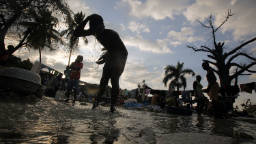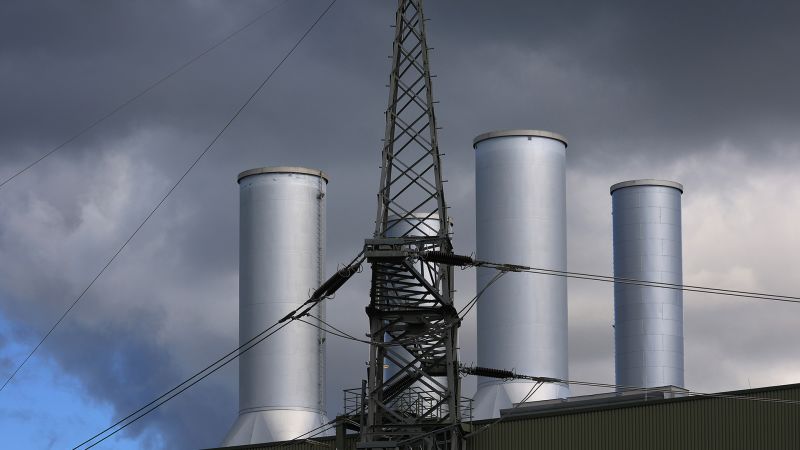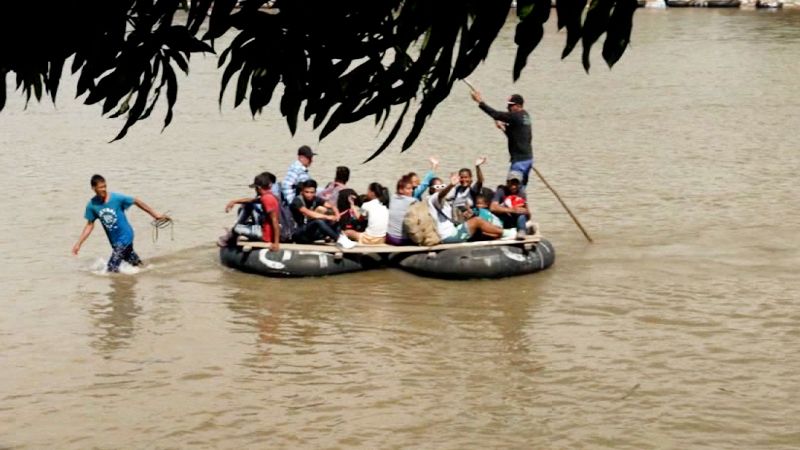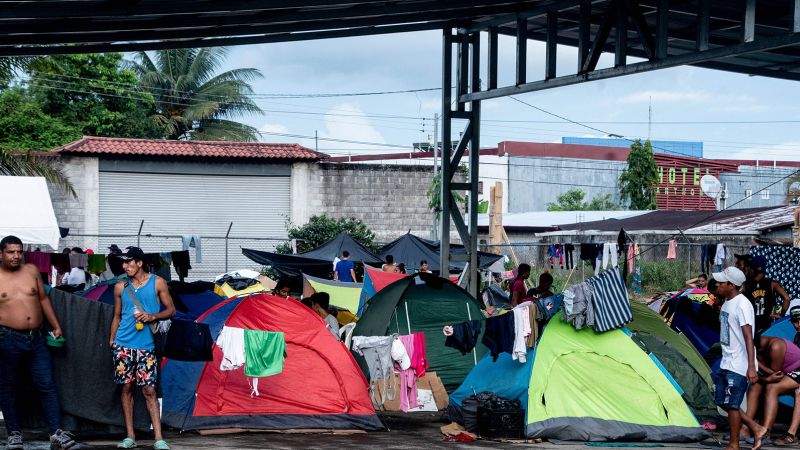Haiti Fast Facts | CNN


CNN
—
Here’s a look at Haiti. Haiti makes up he western one-third of the island of Hispaniola in the Caribbean. The eastern two-thirds of the island is the Dominican Republic.
(from the CIA World Factbook)
Area: 27,750 sq km (slightly smaller than Maryland)
Population: 11,334,637 (2022 est.)
Median age: 24.1 years
Capital: Port-au-Prince
Ethnic Groups: Black 95%, mixed and White 5%
Religion: Catholic 55%, Protestant 29%, Vodou 2.1%, other 4.6%, none 10.8% (2018 est.)
Unemployment: 40.6% (2010 est.)
Pre-1492 – Occupied by the Taíno, an Arawak group of Indigenous peoples.
1492 – Christopher Columbus lands on the island and names it Hispaniola. Spanish settlers proceed to enslave the Indigenous peoples and import slaves from Africa and other Caribbean islands. By 1514, the Taino population is decimated due to disease and forced labor.
1697 – Spain recognizes France’s claim to the western third of the island.
1791 – Slaves rebel against plantation owners. Toussaint L’Ouverture, a former slave, takes control and writes a constitution.
January 1, 1804 – Haiti gains independence from France. Haiti is the second oldest independent nation in the Western Hemisphere after the United States.
1804-1915 – Over 70 different dictators rule Haiti.
1915 – US President Woodrow Wilson sends Marines to Haiti to restore order. The United States occupies Haiti until 1934.
1946 – Army officers take control of Haiti’s government.
1949 – Army officers take control of the government again after rioting breaks out.
1950 – Army officer Paul Magloire is elected president.
1956 – Magloire resigns after rioting breaks out; the army takes control of the government again.
1957 – Francois “Papa Doc” Duvalier, a doctor, is elected president.
1964 – Duvalier declares himself president for life and rules as a dictator.
1971 – Haiti amends their constitution to allow the president to choose his successor. Duvalier chooses his son, Jean-Claude, who is 19.
April 1971 – After his father dies, Jean-Claude “Baby Doc” Duvalier declares himself president for life. He uses a secret police force called Tontons Macoutes (bogeymen) to enforce his policies.
1986 – Duvalier flees the country after a revolt. Lt. Gen. Henri Namphy runs the country and tries to get rid of the Tontons Macoutes but fails.
March 1987 – Haiti adopts a new constitution that calls for presidential and national assembly elections by the people.
November 29, 1987 – Elections are canceled after terrorist attacks on polling places. They are rescheduled for January 1988, at which point the people elect a civilian president and a parliament.
June 1988 – Namphy overthrows the new government and declares himself the president of the military government.
September 1988 – Officers of the Presidential Guard seize power from Namphy. Lt. Gen. Prosper Avril declares himself president.
March 1990 – Avril resigns due to protests.
December 1990 – Jean-Bertrand Aristide wins Haiti’s first free election.
September 1991 – Aristide flees the country after being ousted in a military coup. The Organization of American States and the United Nations lead trade boycotts to force Aristide’s return to power. Many Haitians try to flee to the United States but are forced back to Haiti. Later the refugees are sent to Guantanamo Bay, Cuba.
July 3, 1993 – The military government agrees to allow Aristide to return and restore his government by October 30. They later back out of the agreement and do not allow Aristide to return.
September 17, 1994 – US President Bill Clinton sends a delegation to Haiti in hopes of avoiding a military conflict. The team includes former US President Jimmy Carter, Colin Powell, and Senator Sam Nunn. The peace deal prevents an outbreak of fighting.
September 18, 1994 – The United States sends troops to Haiti to maintain order. The first 3,000 troops land on September 19 in Port-au-Prince.
October 1994 – Aristide is restored to power. US troops stay in Haiti to maintain order. The United Nations and OAS boycotts end and the refugees at Guantanamo Bay return to Haiti.
March 1995 – Most US troops leave Haiti.
Late 1995 – Rene Preval, a member of Aristide’s Lavalas coalition, is elected president.
April 1996 – The last US troops leave.
December 1998 – UN peacekeepers withdraw.
November 2000 – Aristide is elected president again; most other parties boycott the elections, claiming they are fraudulent.
February 2004 – Rebels and political opposition leaders oppose Aristide’s leadership and methods and want him to be removed from power. Aristide says he will remain in office until the last day of his term, February 7, 2006.
February 8, 2004 – Looting and violence spread throughout Haiti.
February 21, 2004 – An International assessment team made up of officials from the United States, France, Canada, the Caribbean Community and the Organization of American States arrive in Haiti to present Aristide with a peace plan. He accepts the terms of the plan, which include the appointment of a new prime minister, the establishment of a bipartisan cabinet, the holding of new elections to be overseen by international observers and the disarmament of militias, stationed in much of the north. The opposition leaders announce the rejection of any plan that does not include the immediate resignation of Aristide.
February 25, 2004 – US President George W. Bush states that any Haitians attempting to enter the United States will be turned away by the Coast Guard.
February 29, 2004 – President Aristide leaves for the Central African Republic. Supreme Court Chief Justice Boniface Alexandre replaces him as the nation’s president in a transitional government, as mandated by Haiti’s constitution.
March 2004 – American and French troops deploy as part of a multinational peacekeeping force.
March 2, 2004 – Haitian rebel leader Guy Philippe declares himself the country’s new police chief and calls for the re-establishment of Haiti’s army, which Aristide disbanded in 1991. The United States does not recognize Philippe as the head of the Haitian police.
March 9, 2004 – Gerard Latortue, a 69-year-old international business consultant, is named the new prime minister of Haiti by the US-backed Council of Sages.
April 2004 – The UN Secretary-General recommends the creation of a multidimensional stabilization operation to assist with the situation in Haiti. The operation is called the United Nations Stabilization Mission in Haiti.
June 2004 – A US-led multinational force turns over authority in Port-au-Prince to UN peacekeepers.
February 7, 2006 – After scheduling delays and allegations of election fraud, Rene Preval is elected president of Haiti.
February 2007 – Preval has UN peacekeepers in Haiti begin an offensive against street gangs in Port-au-Prince.
January 12, 2010 – A 7.0 magnitude earthquake strikes 14 miles west of Haiti, destroying most of Port-au-Prince. The earthquake kills an estimated 217,000 people and leaves more than two million homeless.
October 2010 – Cholera breaks out in Haiti, and more than 6,600 die within a year. As of February 2016, Haiti had reported 771,000 cases of cholera and 9,082 deaths due to the 2010 outbreak.
November 28, 2010 – The presidential election is held. In December, the electoral council announces that former first lady Mirlande Manigat has won but lacks the majority of votes needed for an outright victory. The runoff is scheduled for March 20, 2011.
January 16, 2011 – Former dictator “Baby Doc” Duvalier unexpectedly returns to Haiti after almost 25 years in exile.
April 4, 2011 – Preliminary results in the presidential runoff election show musician Michel “Sweet Micky” Martelly with 67.6% of the vote compared to former Haitian first lady Manigat’s 31.5%.
April 20, 2011 – Martelly is officially declared the president of Haiti by the country’s electoral council.
May 14, 2011 – Martelly is sworn in as the president of Haiti.
June 8, 2011 – Heavy rain in Haiti leads to an increase in reported cases of cholera.
July 2011 – According to a US Centers for Disease Control and Prevention report, UN peacekeepers from Nepal most likely caused the October 2010 cholera epidemic.
October 2011 – A CDC report details improvements made in sanitation and education that lowered the mortality rate from cholera in Haiti from four percent to below one percent. Since December 2010, fewer people are dying from the disease despite an increase in number of cases reported.
November 8, 2011 – Haitian cholera victims have filed a petition with the United Nations demanding compensation for their suffering, the victims’ lawyers announce. Haitians who were sickened are demanding $50,000 each; families of those who died are seeking $100,000.
April 14, 2012 – The Haitian government and the World Health Organization launch a cholera vaccination program targeting 100,000 people.
October 2012 – Dozens die in floods and landslides due to Hurricane Sandy.
December 2014 – After days of anti-government protests in Haiti, Prime Minister Laurent Lamothe announces his resignation.
January 9, 2015 – A US federal judge in Manhattan rules that the Haitian victims of the 2010 cholera outbreak cannot sue the United Nations, as it has legal immunity.
January 16, 2015 – Former Port-au-Prince mayor Evans Paul is sworn-in as prime minister.
February 7, 2016 – After five years in office, President Martelly steps down, leaving Haiti with no successor after elections marred by allegations of fraud were postponed. Under the terms of an agreement for a transitional government, Haiti’s parliament will elect an interim president for a term of 120 days and confirm a consensus prime minister.
February 14, 2016 – The Haitian Parliament elects a new interim president, former head of Parliament Jocelerme Privert.
August 18, 2016 – For the first time, the United Nations acknowledges its own involvement in the 2010 cholera outbreak in Haiti.
November 20, 2016 – A presidential election is held with 27 candidates competing.
January 3, 2017 – Jovenel Moïse is officially declared the new president of Haiti. The following month, he nominates Jack Guy Lafontant prime minister.
July 14, 2018 – Lafontant resigns amid violent protests sparked by a proposed plan to raise fuel prices.
August 5, 2018 – President Moïse announces that Jean-Henry Céant will be the nation’s new prime minister.
March 18, 2019 – The majority of Haiti’s Chamber of Deputies votes to dismiss Prime Minister Céant, whose position has not yet been ratified by the national assembly. The no-confidence vote follows recent protests over economic conditions. Jean Michel Lapin is named acting prime minister three days later and is nominated prime minister in April.
June 11, 2019 – The United Kingdom regulator for the British charity Oxfam releases a report regarding Oxfam’s handling of allegations of sexual misconduct in Haiti following the 2010 earthquake. The report finds that the charity “missed opportunities” to address “cultural and behavioral issues” of staff in Haiti at that time. In its responding statement, Oxfam says it accepts the findings of the commission, and is “deeply sorry for its failure to prevent sexual abuse by its former staff in Haiti.”
July 22, 2019 – Officials announce that Prime Minister Lapin, whose position has not yet been ratified by the national assembly, has resigned during continuing anti-government protests. The same day, President Moïse nominates Fritz William Michel as the nation’s prime minister. This is the fourth such nomination since Moïse became head of state.
February 23, 2020 – Haiti’s biggest celebration of the year, Carnival, is canceled after deadly protests and gunfire interrupted the first day of festivities in Port-au-Prince.
February 7, 2021 – Dozens are arrested for an alleged coup attempt, while protesters accuse President Moïse of unconstitutionally extending his term. Moïse is due to step down, according to Haiti’s Superior Court of Justice and the country’s opposition movement.
February 8, 2021 – Haiti’s opposition movement selects Joseph Mecene Jean-Louis, a 72-year-old Supreme Court judge, to lead a transitional government, arguing that President Moïse’s term has expired and calling on him to step down.
July 7, 2021 – Moïse is killed during an attack on his private residence. Acting Prime Minister Claude Joseph assumes leadership and declares a “state of siege” in Haiti, saying he does not want the nation to “plunge into chaos.”
July 19, 2021 – Joseph agrees to step down and hand power to his rival Ariel Henry. Henry will now become prime minister and Joseph will retain his original role as Haiti’s foreign minister, current Elections Minister Mathias Pierre tells CNN.
August 14, 2021 – A 7.2-magnitude earthquake strikes Haiti, leaving at least 2,207 people dead and more than 12,268 injured, according to Haiti’s civil protection agency. The Haitian government declares a state of emergency.
October 5, 2022 – Haitian Prime Minister Henry calls for international help during a televised speech to the nation. Anti-government protests – now in their seventh week – have paralyzed the country, with schools, businesses, and public transportation across the country mostly shuttered. Since August 22, Haitians have been demonstrating against chronic gang violence, poverty, food insecurity, inflation, and fuel shortages.







